Starting on August 18, Led Zeppelin fans were puzzled by a series of black and white video clips seemingly showing previously unseen footage of Led Zeppelin.
These clips, posted by LedZepNews as well as by LedZepFilm and others, led to significant speculation about what exactly was being teased.
Now, we can confirm that the clips originate from professionally shot footage of Led Zeppelin performing “Dazed and Confused” in Amsterdam on October 5, 1969.
The film, long thought to have been lost, was rediscovered in recent months, painstakingly restored and will now be released as a bonus feature on the upcoming Blu-ray release of “Becoming Led Zeppelin”.
The Amsterdam 1969 footage is arguably the most significant newly discovered Led Zeppelin footage to emerge since parts of the pro-shot footage of Led Zeppelin’s June 28, 1970 Bath Festival performance were posted online in 2022.
LedZepNews played a small role in helping release the Amsterdam 1969 footage, sharing the newly discovered archive listing with “Becoming Led Zeppelin” director Bernard MacMahon which kickstarted his restoration process and the upcoming release of the footage on September 30.
Searching for the lost footage
Armed with Dutch newspaper coverage of the performance’s broadcast and a domestic audio recording of the television programme he acquired from Sam Rapallo in 2018, MacMahon spent years searching for the Amsterdam 1969 footage while making “Becoming Led Zeppelin”.
“Even before I actually presented the idea of the film to the group, I was on the search for every piece of footage that I could find that had been filmed in the period that the film covers,” MacMahon tells LedZepNews.
“I remember having close to two years of conversations with the archive attempting to find that footage. And I came to the conclusion that it had been lost.”
To try to track down the footage, MacMahon had even made contact with the family of Dutch filmmaker Frans Zwartjes. It had been rumoured that Zwartjes may have been involved in filming Led Zeppelin’s performance, confusion that likely originated because a separate film from Zwartjes was shown on the same episode of the programme where the Amsterdam 1969 footage was broadcast.
MacMahon had always intended to use the colour “Supershow” footage of Led Zeppelin performing “Dazed and Confused” on March 18, 1969 in his film. “We had already tracked down and transferred the stunning ‘Supershow’ performance, so I thought, well, a 15-minute performance of the same song is too long for the film anyways so after two years searching, I’m just going to throw in the towel. I can’t look for it any longer,” he recalls.
The Amsterdam 1969 footage is found
While “Becoming Led Zeppelin” was being released in cinemas and on streaming services, the lost Amsterdam 1969 footage had quietly been rediscovered.
“I’m still in shock that I found it,” says Charlie Hoch, a user on the Dogs of Doom Discord server. In early 2024, Hoch contacted BNNVARA, the successor to the VARA channel that originally broadcast the “Dazed and Confused” clip in 1969, asking about the fate of the lost film.
“The person who got back to me said that BNNVARA doesn’t hold their own archive, but pointed me in the direction of the archive that does,” he says. “I checked the archive then but didn’t find anything.”
BNNVARA’s archives are held by the Netherlands Institute for Sound & Vision. When Hoch looked into the archives at this time, the Amsterdam 1969 footage wasn’t present.
“After watching ‘Becoming Led Zeppelin’, I became interested in the lead again,” Hoch says. “I went back to the archive and to my surprise I found a listing for the footage. I then sent it over to LedZepFilm and the rest is history.”
Hoch had found that the Netherlands Institute for Sound & Vision’s archives now contained an intriguing listing for a copy of the November 12, 1969 episode of arts programme “Dit is het begin”, the show in which the video of “Dazed and Confused” was broadcast.
Hoch shared his discovery with LedZepFilm, who we’ve collaborated with extensively to release videos and photos of Led Zeppelin. Realising the significance of the find, he flagged it to LedZepNews which brought the film one step closer to MacMahon.
In a March phone call, LedZepNews revealed to MacMahon that the lost Amsterdam footage had been found and that it appeared to be extremely good quality early footage of Led Zeppelin.
“I was literally completely stunned when you mentioned this because I’d been searching, getting them to look everywhere for that for so long, I was staggered,” MacMahon says.
The footage had been missing from the archives for decades but had only recently been returned to its collection.
“After the broadcast, the editor of the clip had taken it home with him,” MacMahon explains. “It had stayed in his personal collection for 55 years. And unfortunately, he’d developed dementia.”
“His son had contacted the archive saying ‘My father was a noted editor. He’s sitting on all these reels of film. And because, unfortunately, he no longer has the faculties to deal with this material, I wondered if you’d be interested in it.’”
The rediscovery of the footage came too late for the main documentary, a fact that would frustrate many filmmakers. Was MacMahon annoyed at missing out on the Amsterdam footage for “Becoming Led Zeppelin”?
“Not at all. We couldn’t have found it because it was on [an] editor’s shelf and no one knew who that was. No one could point us to that person,” he says. “There was no editorial record of him working on that film. So there was no way of getting to that person.”
“And when it appeared it was absolutely perfect for the Blu-ray release. I’m not going to have a seven-minute performance of ‘Dazed and Confused’ followed by a 15-minute performance of ‘Dazed and Confused’ in the same movie. But as a standalone short it’s absolutely mindblowing because it’s so different musically and no one has ever seen it except for a few Dutch people 56 years ago.”
MacMahon explains he seeks to make “definitive” films where “there is literally no point in going back and trying to do that again.”
Watching the lost film
After years of searching, MacMahon was finally given a digital copy of the footage to review. “When we finally got to see it, I was stunned at how good the footage looked [and] how well it was shot,” MacMahon says.
“For an additional feature on a Blu-ray, this footage is absolutely your dream come true because it’s the same song, but it is so different,” he adds. “It’s absolutely fascinating to look at it and it gives you the best insight without a single word being spoken as to what it was that was interesting about this group.”
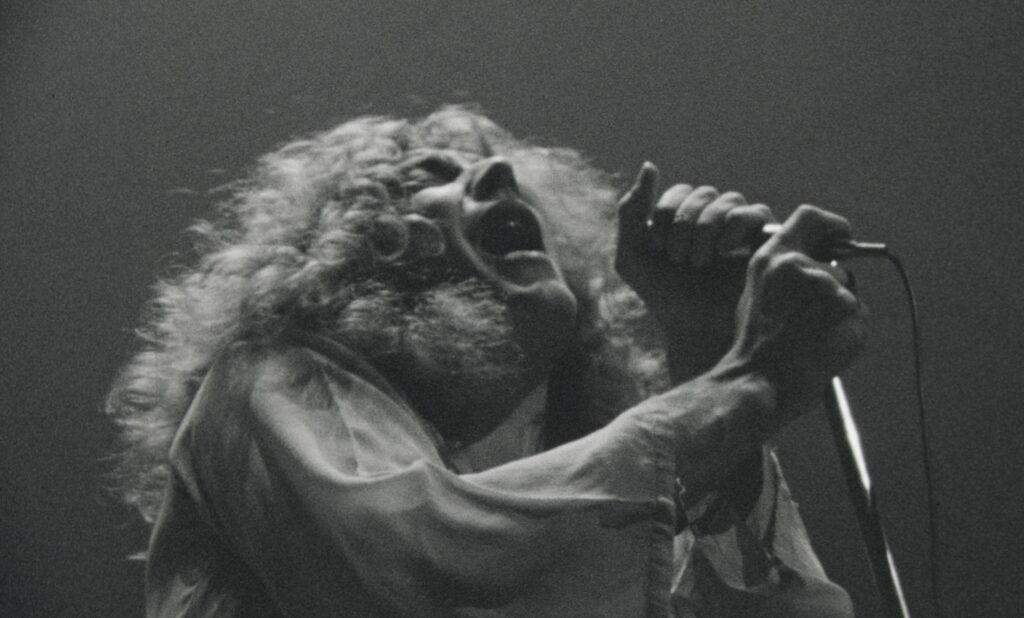
But MacMahon’s initial excitement at seeing the footage after years of searching quickly turned to concern.
“After the initial thrill at how brilliant it looked, I have to say I was kind of horrified at how terrible the transfer that we’d been sent from Amsterdam sounded. And I could tell there were major issues with the audio elements, probably because of damage through age and also the transfer itself, which is no criticism of the archive,” he says. “It’s just that we really don’t make the machinery anymore to deal with compromised audio from that period.”
The challenge now was whether the archives could be persuaded to send the film to the US, where MacMahon worked with a state of the art facility that could carry out a new transfer of the video and audio, restoring it to make it suitable for a Blu-ray release.
“Almost all the major archives in the world that hold film and audio elements have a policy not to let that material leave the archive,” MacMahon says. “This is because generally over the years, for various reasons, things have gone missing.”
MacMahon was eventually able to persuade the archives to let the footage travel overseas thanks to an unlikely saviour: his work on the original footage of the Hindenburg disaster which is held by the National Archives in the US.
Restoring the Hindenburg footage
An early version of “Becoming Led Zeppelin” opened with an extended introduction that used newly restored video and audio showing the Hindenburg’s 1937 journey and its fiery end. To create this montage, MacMahon and his team worked with the National Archives to retransfer its Hindenburg footage, including journalist Herbert Morrison’s live audio reaction to the disaster recorded on lacquer discs.

“Allison [McGourty], my producer and partner and co-writer of the film, she talked to the head of the National Archives and she managed to make them do something I don’t think they’ve ever done before which is with a security guard accompaniment to ship those lacquers, which had never been played since 1937, out to our facility in Burbank and we transferred them there,” MacMahon explains.
“The grooves of the disc had been damaged by the force of the explosion and had never been able to be played before. So on all the newsreels they had used sound effects. We were able to navigate the grooves and for the first time in history we could hear the actual explosion of the Hindenburg and the voices of the people screaming and all the tumult,” he says.
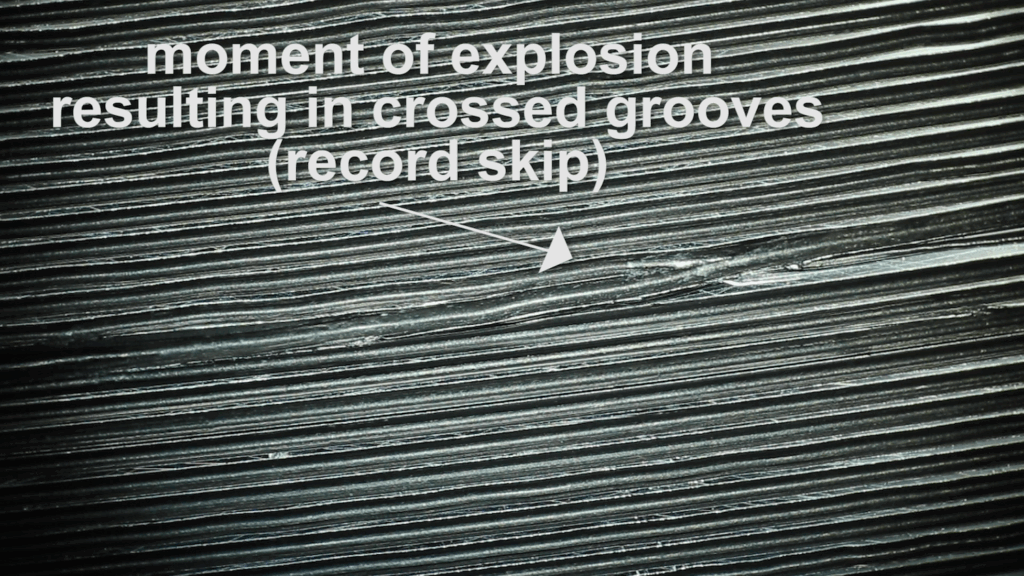
It was only when MacMahon watched the initial introduction to the film that he realised it wasn’t going to work for the start of “Becoming Led Zeppelin”.
“The way human beings respond to audio on such an emotional level, the sequence at the beginning, as I’d originally conceived it, with the crystal clear real sound of the disaster was so horrifying that you literally could not begin the story of four boys in post-war Britain getting into music,” MacMahon explains.
The Hindenburg introduction was cut from “Becoming Led Zeppelin”, although it may resurface as a short film in the future according to MacMahon. However, it did serve as a case study MacMahon could share with the Dutch archives, showing how he worked with some of the most legendary archive footage in the world.
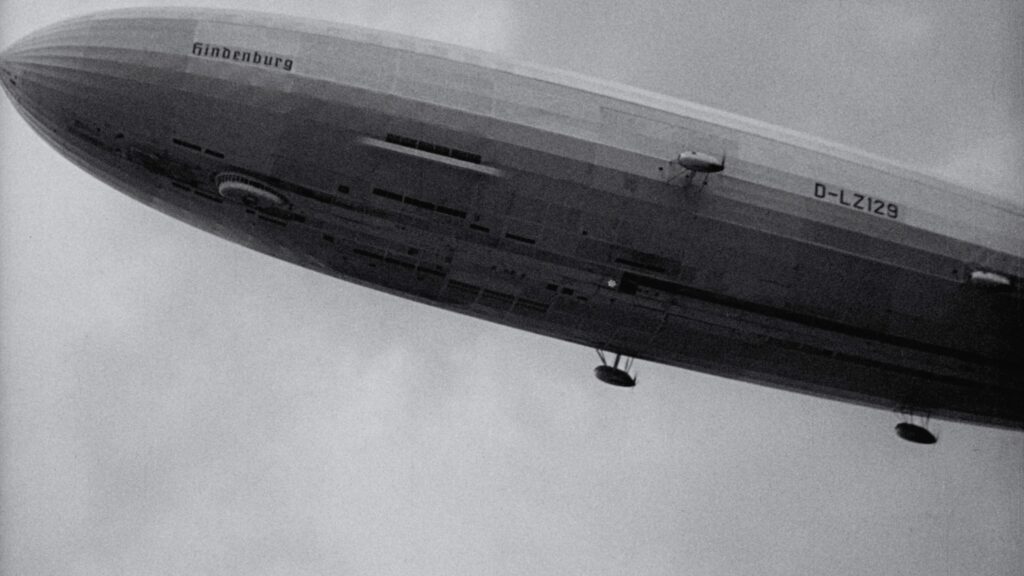
The Dutch archives agreed to let the newly discovered Amsterdam 1969 footage leave its facilities accompanied by archivist Tonnie van Els as it made its way to California where MacMahon’s team carried out a new transfer of the audio.
Restoring the audio
With the film transferred in the best possible quality, the challenge was fixing issues with the video and audio to prepare it for release. The audio presented the biggest challenge.
“The most severe problem with the film was that the mag track, which is essentially like a film reel except it has audio on it, had developed vinegar syndrome, and that in essence is when the film literally smells like white vinegar,” MacMahon says. “Vinegar syndrome on film is terminal.”
Acetate film base degradation, to give vinegar syndrome its technical name, causes aging film to become brittle and shrink, eventually damaging it beyond repair sometimes in a handful of years.
“It’s a race against time, and in this case with this film, talking with our transfer engineer Nick Bergh, if you waited another five years, this mag track would be completely unusable,” MacMahon says.

Thankfully, the film had been transferred and salvaged in digital form before the physical reels were unusable. But the damage had already caused issues with the audio for “Dazed and Confused”.
“It warps that mag reel so that the playing surface … is wavy, and that means that if you’re trying to play it, you do not have purchase on the surface of the track in order to get the audio off that you need,” MacMahon says.
“So you start to have things like the drums will come in and out of focus, the balances will shift, and since this recording is a board recording that is clearly being mixed on the fly, they’re shifting the instrument levels up and down during the performance [so] you particularly need to have a really good transfer. You really need to have purchase so that the actual transfer is rock solid.”
The mag track had also been damaged after someone had tried to play it, meaning it “essentially flew off the reel, and the sprockets that were turning it around had punctured the playing surface,” MacMahon says.
The result of all this damage was that the audio track in the centre of the tape had “deep indentations where the sprockets had run through for approximately like a minute of playing time”.
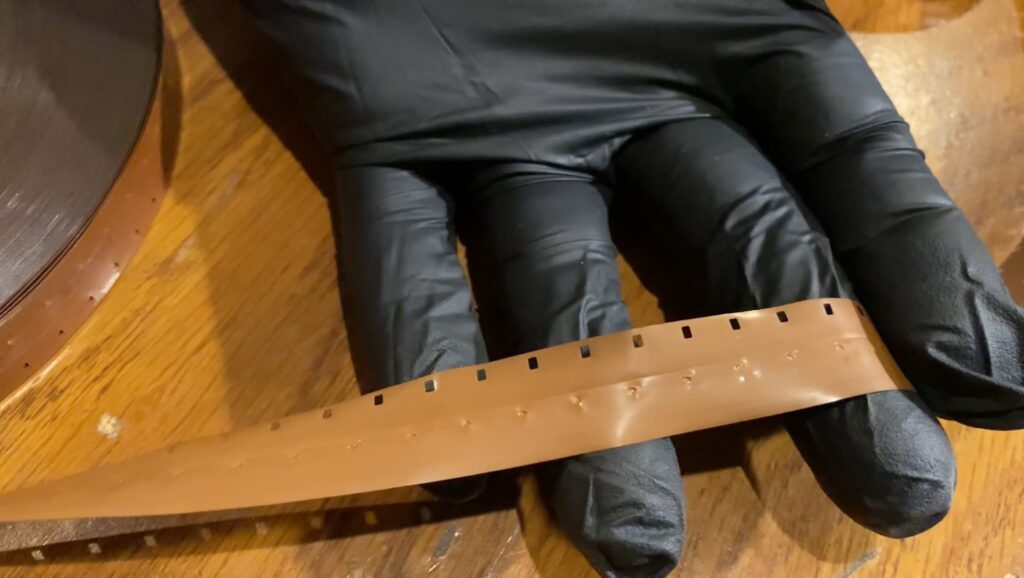
To fix the problem, MacMahon’s team began laboriously working with hand tools to push in the divots made by the sprocket, attempting to make the playing surface as flat as possible and to fix the damaged mag track.
“It’s a very careful, time-consuming process,” MacMahon says. “Every point where the sprockets have hit the mag surface, i.e. they’ve not gone in the sprocket hole, they’ve hit the playing surface. They’ve essentially pushed up an area where the music is recorded so that when it runs over the tape, it’s not even touching on the playing heads, which without our corrections would have resulted in a warbling sound to the audio.”
Once that had been fixed as much as possible, the team then used machines that are designed to play warped reels, exactly like the “Dazed and Confused” audio track.
“This is the only gear in the world that would be able to get this quality of sound off this mag reel,” MacMahon says. “The Blu-ray edition of this film is the only way that this piece of film would ever survive for future generations in a high-quality form.”
Restoring the video
The film’s video was less damaged, but still required work. That was due in part to what MacMahon calls, with a laugh, “the worst stuff on planet Earth”: Sellotape.
The original edits made to the footage in 1969 had been joined together with tape, which had turned dark yellow and brown with time. Frames either side of these cuts now appeared discoloured due to the tape.
“In the world of antiques, my mother was an antique dealer, your greatest enemy is sellotape,” MacMahon says. “Because when it ages, the glue hardens and it turns brown, and the glue leaves this staining on whatever the tape was used to stick together.”
“That browning that happens, that leaches into the surface of what it’s been stuck to. If you talk to any restorer, it’s one of the few things that is literally unremovable, you can’t get it out.”
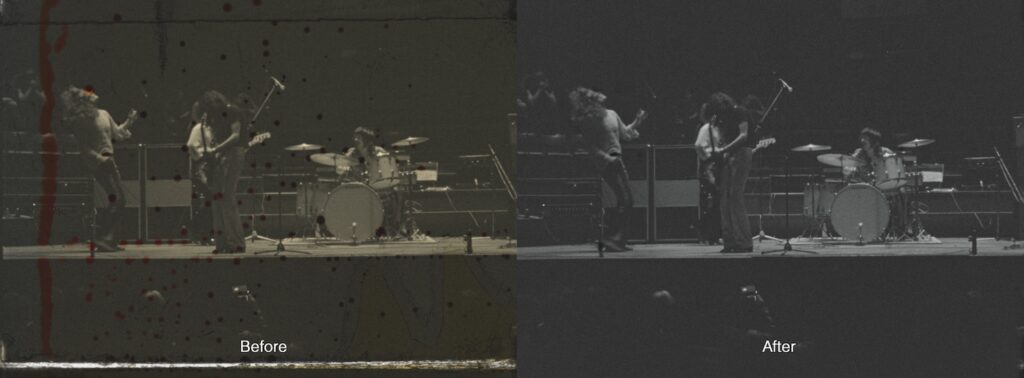
Manual repair of the physical film wasn’t possible, so MacMahon’s team, led by editor Dan Gitlin, used digital tools to carefully take sections of consecutive frames to repair the tape damage.
“So we have to use the scan, then manually in Avid we have to take a piece of the previous frame where the tape is not sitting, that is just slightly bigger than the damaged tape area, and then superimpose that over that part of the frame,” MacMahon says. “It is a very, very, very laborious process.”
MacMahon takes care to point out that the damaged frames weren’t restored using artificial intelligence. Instead, painstaking digital repair work was carried out. “We’re literally cut and pasting one piece of film that’s undamaged over an almost identical frame, but just over the damaged area,” he says.
Releasing the lost footage
After months of work, the rediscovered footage was restored and ready for release. It’s the centrepiece of the special features of “Becoming Led Zeppelin”, a standalone short film MacMahon has titled “Encore”.
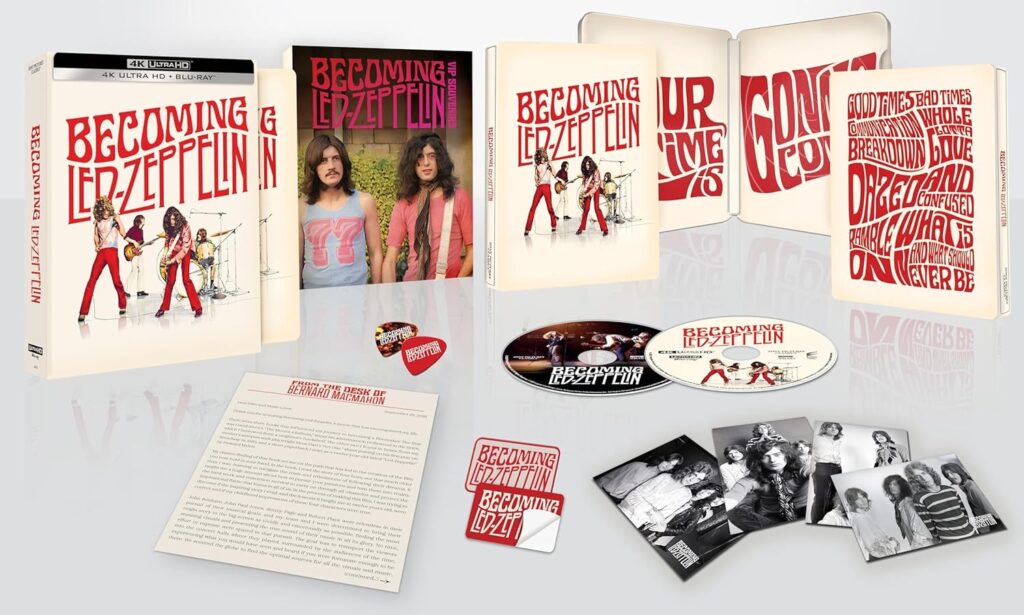
To promote the release of the footage and the Blu-ray release of “Becoming Led Zeppelin”, Sony Pictures approached LedZepNews, LedZepFilm and others. After signing a strict non-disclosure agreement, we were handed silent five-second clips of the Amsterdam 1969 footage and allowed to release them online on August 18, kickstarting speculation about what exactly the footage was.
For MacMahon, the Amsterdam 1969 footage as well as the process of finding and restoring it encapsulates the collaborative approach seen in Led Zeppelin as well as in the making of “Becoming Led Zeppelin”.
“It’s a film about how collaboration is essential to remain in this world. It’s totally essential. We have to work symbiotically,” he explains. In the Amsterdam 1969 footage, “you can see how they’re working together and looking at each other and interacting,” MacMahon says.
It’s especially fitting that the film has been released and restored in part due to collaboration between Hoch, LedZepFilm, LedZepNews and MacMahon.
“You knew how much we cared about this stuff and you thought, ‘I’m sure they’ll do the best job with this’,” MacMahon says. “The whole village comes together and you put all this stuff together. And this is how the world should be.”
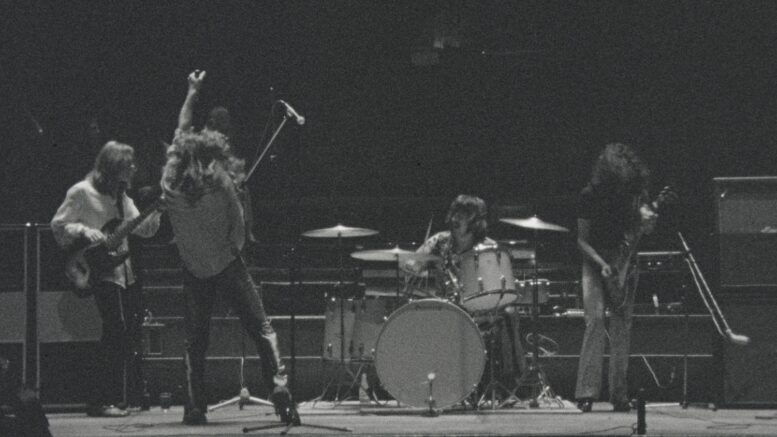
Congrats and thanks for searching and finding, restoring and editing for us this material, thank you.
Hopefully someone will now have a look for the missing film of the Rotterdam rock festival from June 1970.
“…And this is how the world should be.” Indeed!
Excellent news I’ve gotta experience this footage as my collection had everything ever put out on bootleg in any form from 1968, 1969 and 1970, my favorite Led Zeppelin years.
Any ideas when the Blu-ray will be available to purchase in the UK?
This will be blasting on my home screen!!